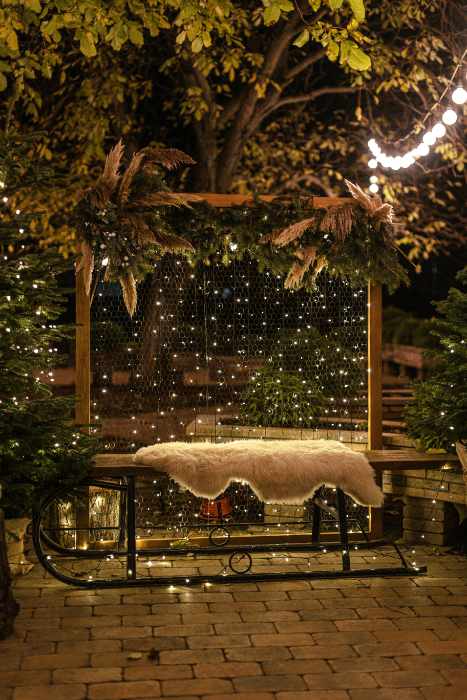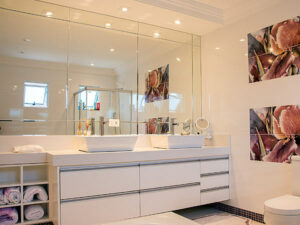Outdoor lighting has the remarkable ability to transform the ambiance of your outdoor space. Among the various lighting techniques, accent lighting stands out for its ability to highlight specific features, adding depth, drama, and character to your landscape. In this article, we explore the art of accent lighting and how you can use it to showcase the best features of your outdoor space.

When designing the perfect outdoor entertainment area, good lighting must play a role. Whether it’s a majestic tree, a stunning sculpture, or a charming pathway, accent lighting can enhance the beauty of these features and create a captivating outdoor environment.
Understanding Accent Lighting
Accent lighting is a technique used to draw attention to a particular object or area. Unlike general or ambient lighting, which provides overall illumination, accent lighting focuses on highlighting specific features, creating visual interest and depth. This type of lighting is often used in outdoor spaces to showcase architectural elements, landscaping features, or decorative items.
Types of Accent Lighting
Several types of accent lighting can be used to enhance your outdoor space:
1. Uplighting: Uplighting involves placing light fixtures at ground level and directing the light upward. This technique is effective for highlighting trees, shrubs, and architectural features such as columns or statues. Uplighting creates a dramatic effect by casting shadows and emphasizing the texture of the objects.
2. Downlighting: Downlighting, also known as moonlighting, involves placing light fixtures above the object or area to be illuminated and directing the light downward. This technique mimics the natural effect of moonlight filtering through the foliage. Downlighting is ideal for highlighting pathways, patios, and outdoor seating areas.
3. Grazing: Grazing involves placing light fixtures close to a surface and aiming the light parallel to the surface. This technique creates a striking effect by highlighting the texture of the surface, such as a stone wall or a textured facade. Grazing can add depth and dimension to your outdoor space.
4. Silhouetting: Silhouetting involves placing a light source behind an object to create a silhouette effect. This technique is often used to highlight the outline of trees or statues against a wall or backdrop. Silhouetting can create a dramatic and artistic effect in your outdoor space.
5. Shadowing: Shadowing involves placing a light source in front of an object to create a shadow on a surface behind it. This technique can be used to create a dramatic effect by casting a large shadow of a tree or statue on a wall or the ground. Shadowing adds depth and interest to your outdoor space.
6. Cross lighting: Cross lighting involves illuminating an object or area from two or more directions. This technique can create a balanced and uniform lighting effect, highlighting the details of the object from different angles. Cross-lighting is often used to illuminate large trees or sculptures.
Choosing the Right Fixtures
When selecting fixtures for accent lighting, consider the following factors:
1. Fixture Type: Choose fixtures that are suitable for outdoor use and are designed to withstand the elements. Common types of outdoor lighting fixtures include floodlights, spotlights, and well lights.
2. Light Source: LED lights are energy-efficient and long-lasting, making them ideal for outdoor accent lighting. Choose a color temperature that complements the features you are highlighting, such as warm white for a cozy ambiance or cool white for a modern look.
3. Beam Angle: Consider the beam angle of the fixture, which determines the spread of light. A narrow beam angle is suitable for highlighting specific objects, while a wide beam angle is ideal for illuminating larger areas.
4. Installation: Ensure that the fixtures are installed securely and are positioned correctly to achieve the desired lighting effect. Consider using a professional installer for complex lighting projects.
Design Tips for Accent Lighting
Here are some design tips to help you make the most of accent lighting in your outdoor space:
1. Highlight focal points: Use accent lighting to highlight focal points such as trees, sculptures, water features, or architectural elements. This will draw attention to these features and create a visually appealing landscape.
2. Create depth and dimension: Use a combination of uplighting, downlighting, and grazing to create depth and dimension in your outdoor space. This will add visual interest and make your landscape more dynamic.
3. Use multiple light sources: Instead of relying on a single light source, use multiple light sources to create a layered lighting effect. This will add depth and texture to your outdoor space.
4. Consider the surroundings: Take into account the surrounding environment when designing your accent lighting. Consider how the lighting will interact with other elements in your landscape, such as plants, hardscapes, and architectural features.
5. Use lighting controls: Consider using lighting controls such as dimmers, timers, and motion sensors to customize your outdoor lighting. This will allow you to adjust the lighting levels based on the time of day or the desired ambiance.
Additional Factors to Consider
1. Light Pollution: Be mindful of light pollution and its impact on the environment and neighboring properties. Use fixtures with shields or louvers to direct light downward and minimize light spillage.
2. Safety and Security: Ensure that your outdoor lighting design provides adequate illumination for safety and security purposes. Light pathways, stairs, and entryways to prevent tripping hazards and deter intruders.
3. Energy Efficiency: Choose energy-efficient fixtures and light sources to reduce energy consumption and lower utility costs. LED lights are a great choice for outdoor lighting due to their energy efficiency and long lifespan.
4. Maintenance: Consider the maintenance requirements of your lighting fixtures. Choose fixtures that are easy to access and maintain to ensure they remain in good working condition. Get in touch with professionals to learn more about maintenance.
5. Weather Resistance: Select fixtures that are designed to withstand the outdoor elements, such as rain, snow, and UV exposure. Weather-resistant fixtures will ensure longevity and reliable performance.
6. Lighting Zones: Divide your outdoor space into lighting zones based on the desired function and ambiance. For example, you may have a zone for dining, another for lounging, and another for highlighting focal points.
7. Neighborhood Guidelines: Check with your neighborhood association or local authorities for any guidelines or restrictions on outdoor lighting design. Compliance with these guidelines will help you avoid any issues or conflicts with neighbors.
8. Professional Consultation: Consider consulting with a professional lighting designer or landscape architect to help you design a lighting plan that meets your needs and enhances the beauty of your outdoor space.
Conclusion
Accent lighting is a powerful tool that can transform your outdoor space into a captivating and inviting environment. By using the right techniques and fixtures, you can highlight the best features of your landscape and create a stunning visual impact.
Whether you’re illuminating a majestic tree, a tranquil pond, or a charming pathway, accent lighting can enhance the beauty and charm of your outdoor space, making it a place where you love to spend time.



